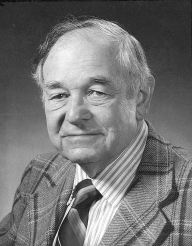- Home
-
Research Groups
Division Groups
- Artificial Photosynthesis
- Catalysis: Reactivity & Structure
- Electrochemical Energy Storage
- Electron- and Photo-Induced Processes for Molecular Energy Conversion
- Neutrino and Nuclear Chemistry
- Surface Electrochemistry and Electrocatalysis
Associated Groups
- Catalysis for Alternative Fuels Production
- Nanostructured Interfaces for Catalysis
- Structure and Dynamics of Applied Nanomaterials
- People
- Operations
- News
- Events

Electron- and Photo-Induced Processes
Augustine Oliver Allen (1910-1988)
 Augustine "Gus" Allen, a founder of modern radiation
chemistry, spent most of his professional career at Brookhaven National
Laboratory. When he arrived in 1948, the Laboratory and the Chemistry Division were brand new, and Gus' five years of experience in radiation
chemistry qualified him as an elder statesman in the field. He was already
recognized internationally as "the" authority on the radiation chemistry of
water and aqueous systems. During that five years he developed the theory of
free-radical recombination in densely-ionized tracks. This theory has since
been fleshed out experimentally and theoretically by workers in many
countries and is the cornerstone of much of radiation chemistry.
Augustine "Gus" Allen, a founder of modern radiation
chemistry, spent most of his professional career at Brookhaven National
Laboratory. When he arrived in 1948, the Laboratory and the Chemistry Division were brand new, and Gus' five years of experience in radiation
chemistry qualified him as an elder statesman in the field. He was already
recognized internationally as "the" authority on the radiation chemistry of
water and aqueous systems. During that five years he developed the theory of
free-radical recombination in densely-ionized tracks. This theory has since
been fleshed out experimentally and theoretically by workers in many
countries and is the cornerstone of much of radiation chemistry.
Gus saw in radiation chemistry a real challenge to systematize an area that
many thought of as a hopeless morass. Much of the evidence for the nature
and identity of the hydrated electron was developed in his laboratory. He
also made major contributions to the study of ionization in low dielectric
liquids, particularly in hydrocarbons. He originated the study of radiation
effects on liquids adsorbed on relatively inert solids, such as silica gel,
and demonstrated for the first time that much of the energy absorbed in the
solid migrates to the surface and produces disproportionate effects on the
adsorbed material. He maintained a life-long interest in the application of
radiation chemical studies to radiobiology and collaborated on much of the
work characterizing the free radicals involved, particularly the superoxide
radical.
Many of the people who worked with Gus over the years left to form their own laboratories around the world. Many others worked with him during his visits to their laboratories. Many who never worked with him remember his strong interest in discussing their work with him and appreciate his insights. We, the members of the group he founded at Brookhaven, are very pleased for this opportunity to acknowledge our debt to him.




